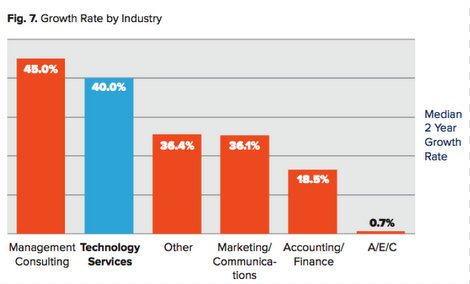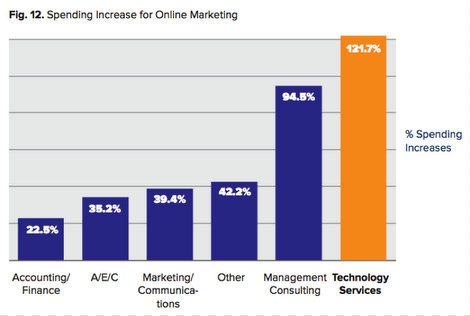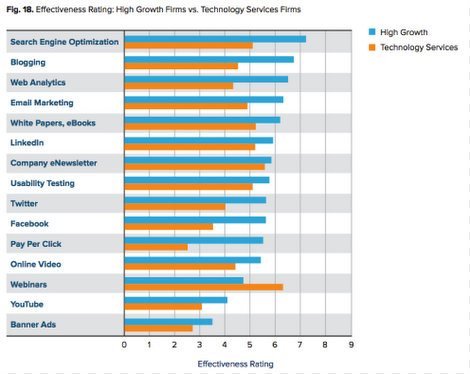Hinge recently conducted a research study on the usage of online marketing by technology professional services firms. The data shows that technology firms are one of the fastest growing industries in terms of revenue.

Additionally, out of the 49 tech firms surveyed, 72% planned on increasing spending in online marketing within the next year. On average, those firms planned on increasing spending by 121%, well more than any other industry surveyed.

What is driving this growth? On which marketing channels are these firms focusing? It’s really no secret. High growth tech firms are concentrating their efforts on a few key online techniques and watching inbound lead flow translate into sustained revenue growth.
Build a Website that is Truly Great
Easier said than done, right? Unfortunately, there is no way around it. Having a website that makes prospects say, “Wow, this firm is a true leader,” is half the battle. The problem these days is that a website can go out of date in a year or two. Right when you’ve finished your masterpiece, it’s time to start thinking about the next round of design.
Our data shows that out of all professional services firms, the high growers have redesigned their site within the last year. See how that stacks up to tech firms in general:

If you are in any technology business, having an updated website is an absolute must. What does it say about your brand if you are behind the times? If you want a chance at high growth then invest in a new website this year.
Now That You’ve Built the Monster, Feed It!
A website alone will not lead to optimal growth. After investing in a new website, firms are then focusing their marketing funds on certain online marketing tactics.
We asked tech firms which online techniques were most effective in generating new leads. We then compared this to all high growth professional services firms. As the data illustrates, technology firms were a bit all over the place with what they responded as being effective. But if you focus on high growth firms, there are a handful of techniques that seem to be most effective.

Although there are many ways you can spend your 2013 marketing budget, strongly consider these four areas as top priorities.
1. SEO – We know for a fact that people look for technology services in Google and other search engines. If someone needs a business intelligence consultant, they search online. Looking for an Oracle or Microsoft expert? Same thing. Spending marketing budget on being found in search engines just makes sense.
2. Blogging – Publishing educational content to your site is a sure way to grow your online reach. It’s your chance to position your firm as a thought leader and a technical expert. As you blog, your posts will show up in search results and also be passed around in social networks, leading to traffic and visibility.
3. Web Analytics – High growth firms measure their progress—plain and simple. If your firm is putting effort into online marketing this year, make sure you track progress over time. This includes not only how much traffic your site is generating, but where that traffic is coming from and whether it is converting into new leads. Most of the important analytics you need are free with Google Analytics, so there are no excuses. You are a technology firm so use this crucial technology.
4. Email Marketing – Email is a proven way to nurture your contacts and convert them into leads. It is an essential piece to most successful professional services marketing campaigns. If you ignore email, you are missing out on business. Use this channel to drive people to your newly created blog content and remind them that your firm is there when they need a trusted technology service provider.
This is an exciting time to be part of the tech industry. As the research shows, growth potential is huge and getting there is a matter of focus and smart marketing. For more insights into online marketing for technology firms, download the entire report here for free. And be on the lookout for our next tech study, How Buyers Buy.
